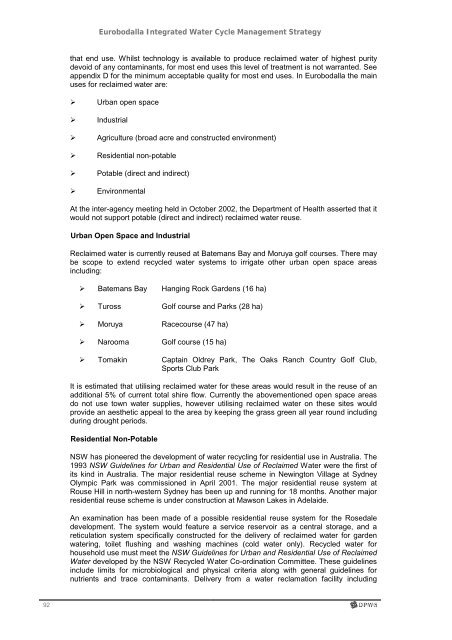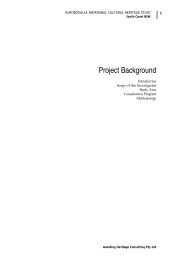Eurobodalla Integrated Water Cycle Management Strategy
Eurobodalla Integrated Water Cycle Management Strategy
Eurobodalla Integrated Water Cycle Management Strategy
Create successful ePaper yourself
Turn your PDF publications into a flip-book with our unique Google optimized e-Paper software.
92<br />
<strong>Eurobodalla</strong> <strong>Integrated</strong> <strong>Water</strong> <strong>Cycle</strong> <strong>Management</strong> <strong>Strategy</strong><br />
that end use. Whilst technology is available to produce reclaimed water of highest purity<br />
devoid of any contaminants, for most end uses this level of treatment is not warranted. See<br />
appendix D for the minimum acceptable quality for most end uses. In <strong>Eurobodalla</strong> the main<br />
uses for reclaimed water are:<br />
Urban open space<br />
Industrial<br />
Agriculture (broad acre and constructed environment)<br />
Residential non-potable<br />
Potable (direct and indirect)<br />
Environmental<br />
At the inter-agency meeting held in October 2002, the Department of Health asserted that it<br />
would not support potable (direct and indirect) reclaimed water reuse.<br />
Urban Open Space and Industrial<br />
Reclaimed water is currently reused at Batemans Bay and Moruya golf courses. There may<br />
be scope to extend recycled water systems to irrigate other urban open space areas<br />
including:<br />
Batemans Bay Hanging Rock Gardens (16 ha)<br />
Tuross Golf course and Parks (28 ha)<br />
Moruya Racecourse (47 ha)<br />
Narooma Golf course (15 ha)<br />
Tomakin Captain Oldrey Park, The Oaks Ranch Country Golf Club,<br />
Sports Club Park<br />
It is estimated that utilising reclaimed water for these areas would result in the reuse of an<br />
additional 5% of current total shire flow. Currently the abovementioned open space areas<br />
do not use town water supplies, however utilising reclaimed water on these sites would<br />
provide an aesthetic appeal to the area by keeping the grass green all year round including<br />
during drought periods.<br />
Residential Non-Potable<br />
NSW has pioneered the development of water recycling for residential use in Australia. The<br />
1993 NSW Guidelines for Urban and Residential Use of Reclaimed <strong>Water</strong> were the first of<br />
its kind in Australia. The major residential reuse scheme in Newington Village at Sydney<br />
Olympic Park was commissioned in April 2001. The major residential reuse system at<br />
Rouse Hill in north-western Sydney has been up and running for 18 months. Another major<br />
residential reuse scheme is under construction at Mawson Lakes in Adelaide.<br />
An examination has been made of a possible residential reuse system for the Rosedale<br />
development. The system would feature a service reservoir as a central storage, and a<br />
reticulation system specifically constructed for the delivery of reclaimed water for garden<br />
watering, toilet flushing and washing machines (cold water only). Recycled water for<br />
household use must meet the NSW Guidelines for Urban and Residential Use of Reclaimed<br />
<strong>Water</strong> developed by the NSW Recycled <strong>Water</strong> Co-ordination Committee. These guidelines<br />
include limits for microbiological and physical criteria along with general guidelines for<br />
nutrients and trace contaminants. Delivery from a water reclamation facility including

















